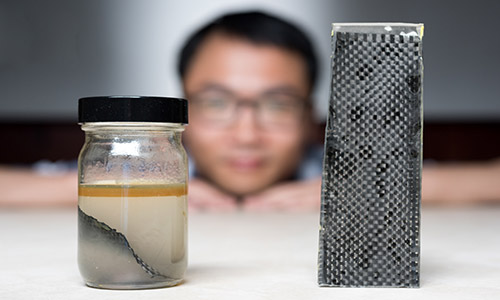By Mike Pickford
Atlanta, Georgia — September 7, 2016 — According to reports, a group of researchers at the Georgia Institute of Technology may be responsible for one of the most ground-breaking discoveries relating to the collision repair industry in recent memory after it was revealed the team had developed a method to recycle almost 100 percent of the materials found in certain forms of thermoset carbon fibre composites.
As reported in the US university’s Research Horizons magazine, the group discovered they were able to separate carbon fibres from the epoxy that binds and holds the metal together by soaking it in alcohol. This process slowly dissolves the epoxy and allowed the researchers to strip the carbon fibres away and reuse them.
Carbon fibre of course has long been a popular material choice for those in the collision repair and aftermarket industry thanks to its its unique ability of providing strength while remaining lightweight. The metal though has never truly taken off as an everyday material of the industry, thanks in large part to its expensive cost and poor recycling potential.
With this discovery, many in the industry will be hoping that second challenge will soon be a thing of the past.
Addressing the traditional difficulties the industry has run into when it came to recycling carbon fibre, Jerry Qi, a professor at Georgia Tech’s school of mechanical engineering noted the team had done a remarkable job in finding a way to potentially eliminate the longstanding issue.
“The polymer matrix is usually crosslinked, just like the rubber and it can’t be simply melted; it’s very hard to strip away the polymer to reclaim the embedded carbon fibres, which are more valuable to recycle,” Qi noted.
According to Georgia Tech, the research team behind the discovery focused their efforts on a carbon fibre that uses a special type of epoxy called ‘vitrimer epoxy’ to give the composite component its shape.
“Vitrimers contain dynamic bonds that can alternate their structure without losing network integrity under certain conditions,” said Kai Yu, a former postdoctoral researcher at Georgia Tech who was involved with the project. “We let alcohol, which has small molecules, to participate in the network of alternating reactions, which effectively dissolved the vitrimer.”
She added, “This method, we think, could have a lot of immediate industrial (implications), with lots of economical and environmental benefits.”
Perhaps the most promising revelation in the report is the research team’s theory that they should be able to recycle large pieces of carbon fibre using the method, with Yu stating the process is “simple” and “straightforward.”
“It’s very easy to operate, so there’s no size limit,” Yu said. “It can be easily scaled up.”
The discovery has the potential to be a billion-dollar discovery with Qi stating his belief that the new recycling process could reduce hundreds of thousands of tons of carbon fibre waste generated each year in Europe and across North America.























